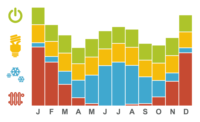Energy Modeling and Today’s Architectural Practice
Integrating energy modeling into architectural practices offers many design, environmental and competitive advantages.












Headlines in this article -
Energy Modeling and Your Client’s Bottom Line
Energy Modeling and Code Compliance
Energy Modeling and the Design Process
What Modeling Approach is Right for Your Firm?
For today’s architect, sustainability has become a core professional value, as fundamental an indicator of project success as commodity, firmness and delight.
Rising energy costs, new energy codes and a heightened awareness of the benefits of sustainability have created a demand for architects who are not only great designers and problem solvers, but experts in sustainability as well.
In the current competitive climate, architectural firms that demonstrate expertise in energy efficiency and sustainability will thrive. Energy modeling — long considered a “technical” task to be relegated to engineers and specialists — can be a powerful tool in architectural practice. When integrated into the design process, energy modeling helps the architect assume a leadership role in sustainable design, adding value to the services offered to clients and ultimately improving the quality of the finished buildings.
Energy Modeling and Your Client’s Bottom Line
Perhaps the most immediate advantage of energy modeling in architecture practice is the ability to assess a design’s performance quantitatively. Energy models help architects predict project performance in reference to a number of parameters: including overall energy performance, mold and condensation risks, water usage and user comfort.
This information can be particularly useful in persuading clients to adopt proposed sustainability measures. Convincing a client to spend “just a little bit more” on an energy efficiency measure is usually a tough sell. Energy modeling can translate an idea from the language of the architect (design and construction) to the language of the client (the bottom line).
In its most basic form, energy modeling can be as simple as a conductive heat loss assessment. This exercise can uncover energy/budget “sweet spots,” where a relatively small initial investment yields significant returns. Upgrading code-minimum windows from R-2.5 to R-5, for example, can yield a substantial improvement in energy efficiency. Energy modeling quantifies this improvement, and the measurable energy (and cost) savings can be balanced against initial investment and expected payback. In this way, energy modeling enables the architect to empower the client, providing specific insight into the life-cycle economics of the building investment.
On more sophisticated projects, fully developed energy models can predict energy costs and savings of all building systems, broken down by load types to allow troubleshooting of the biggest energy “sinks.” For the frugal and environmentally sensitive client, energy modeling can provide a life-cycle assessment of energy usage and total environmental impact. When integrated into architectural practice, energy modeling allows architects and their clients to make informed decisions based on budget, operational cost, user comfort and environmental criteria.
Energy Modeling and Code Compliance
In order to address growing climate concerns, energy codes have become increasingly stringent, with a greater emphasis on enforcement. As the lead design professional, architects have been charged with adapting to these requirements, often without the benefit of adequately increased budgets. Energy modeling can assist the architect in delivering a code-compliant project efficiently and within budget.
Traditionally, architects have complied with energy codes by following prescriptive requirements. In this approach, each element of the building is prescribed, as if by recipe in a cookbook. While perfectly acceptable for conventionally constructed projects, prescriptive requirements leave little room for innovative construction techniques or projects with outlier conditions not anticipated by the code.
Here, energy modeling affords the architect a truly valuable commodity: design flexibility. By utilizing an energy modeling/performance approach to code compliance, the design team can take advantage of tradeoffs. Design aspects of special focus, which exceed code minimums, can offset deficiencies in other parts of the project.
For example, New York City row houses often share common side walls with adjacent buildings. These common, or party, walls have very little heat loss as both sides of the walls are heated (or cooled) to a similar temperature. However, in anticipation that an adjacent row house might be demolished or abandoned, New York City energy code requires that these party walls be insulated as if they were exposed to the outside air. Rather than proposing redundant insulation — which is the prescriptive requirement — the architect can utilize energy modeling to demonstrate that an alternate approach performs equally as well as the prescriptive requirement. By increasing insulation at exposed surfaces (roof, front and rear walls), the insulation at the party walls can be reduced to a minimum while still achieving code compliance. (Note: This approach might just meet code when it is assumed that the neighboring buildings are demolished or abandoned. When it is assumed they are occupied — a fair assumption in New York City — the approach far exceeds the code minimums.) The energy model helps the architect overcome blanket prescriptive requirements to arrive at a superior design within the project budget.
In the example above, the architect could use a consultant to perform the energy modeling. There are several good reasons not to sub out this work, not the least of which is the benefit of minimizing surprises. Stricter-than-anticipated code requirements brought to the architect’s attention late in the design process invariably lead to reworking “finished” details, increasing the budget and altering the design schedule. By performing the analysis in-house, the architect can catch potential problems early in schematic phase and build solutions into the design.
Another benefit of bringing energy modeling in-house is the simplicity of common, code-mandated energy modeling programs (i.e., ComCheck and ResCheck). These programs are user friendly, as they are designed for users with a broad range of experience (or inexperience) in energy modeling. Easy to use, these simplified programs utilize modeling concepts similar to those in more powerful programs. In the act of performing a critical project task, the architect enjoys the added benefit of becoming familiar with energy modeling concepts and techniques.
Energy Modeling and the Design Process
By incorporating energy modeling into their firm’s in-house services, architects are adding a valuable tool to their design process. Just as sketching enables the architect to fluidly propose, test and refine spatial concepts in an iterative process, in-house energy modeling allows the architect to freely hypothesize and adjust sustainable proposals at every design phase.
At the outset of the project, schematic studies give broad stroke feedback on the “big” design moves. While the design is sufficiently plastic, the architect can manipulate building orientation and massing to study solar gain, ventilation and lighting. This process allows the architect to find, and evaluate with real data, ideal relationships between the program and the site.
As the project progresses, in-house modeling affords the architect full control over the integration of sustainable measures into the project. Rather than hiring consultants to produce models with sporadic input and oversight (the proverbial “black box”), the architect/energy modeler controls which energy measures will be tested, and can adjust on the fly.
This level of control is especially useful in the development and detailing phases. The architect is uniquely positioned to assess tradeoffs between competing priorities. If, for example, space on a particular project is extremely tight, the architect is best able to evaluate the relative performance of a stud wall with external rigid insulation versus a double stud-wall system. Simultaneously, the architect with in-house energy modeling can make adjustments to satisfy building science, embodied energy, code compliance, aesthetic and budget concerns.
What Modeling Approach is Right for Your Firm?
When considering in-house energy modeling, where does the architect begin? There are a number of questions to ask that can help guide the decision-making process.
Who will perform the energy modeling? Will the firm utilize (and train) existing employees, or hire experienced energy modelers? For small firms, where architects typically must contribute in all phases of the practice, dedicated energy modeling personnel may not be an option. Conversely, large firms with departmental structures may find that training existing designers or draftspersons is an inefficient use of resources. Many firms are, or soon will be, upgrading to BIM. These firms should consider taking the opportunity to simultaneously train employees in the use of BIM and BIM-integrated energy modeling software.
Perhaps the most fundamental question in regard to energy modeling is: Which software will the firm use? There are hundreds of products on the market with a dizzying range of price, sophistication and functionality. In the face of this surfeit of options, the architect needs to develop a clear understanding of his or her own goals with respect to energy modeling. Is the firm primarily interested in utilizing software for commercial LEED projects? If this is the case, the firm should consider LEED-approved software such as eQuest or Energy Plus. For HERS rating or Passive House projects, architects will need to use RemRate or PHPP (Passive House Planning Package). For visualization of a wide range of environmental factors, architects can explore programs such as Ecotect. For energy code-compliance, firms should check local and state requirements, but many jurisdictions use ComCheck and ResCheck.
There are many resources available to assist architects in comparing energy modeling software. As a first step, architects can use the Department of Energy’s webpage on energy modeling software (www.apps1.eere.energy.gov/buildings/tools_directory/alpha_list.cfm). Architects can also reach out to peers, through informal contacts or organizations such as AIA, for feedback on experience with modeling software. Throughout the investigative process, firms should involve the team members who will be responsible for the energy modeling in the process. Important insight into new technology, prior experiences, and functionality issues can often best be gleaned from within the organization.
The Bottom Line
Once the architecture firm incorporates energy modeling into their in-house services, there should be immediate and positive results. With the output of these models, architects can make informed decisions, explore and fully develop sustainability concepts in the design process, and confidently present their proposals to clients. Integrating this tool into the traditional architectural services is another step toward better buildings, satisfied clients and a more versatile professional practice.
For a single-family home in a rural setting, energy modeling in Ecotect, PHPP and Therm allowed the architect to visualize site orientation ramifications, optimize super-insulation, and assess thermal bridging and condensation risks.
Looking for a reprint of this article?
From high-res PDFs to custom plaques, order your copy today!












